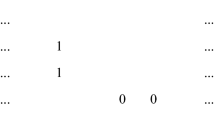Abstract
The combinatorial hierarchy model for basic particle processes is based on elementary entities; any representation they may have is discrete and two-valued. We call themSchnurs to suggest their most fundamental aspect as concatenating strings. Consider a definite small number of them. Consider an elementary creation act as a result of which two different Schnurs generate a new Schnur which is again different. We speak of this process as a “discrimination.” By this process and by this process alone can the complexity of the universe be explored. By concatenations of this process we create more complex entities which are themselves Schnurs at a new level of complexity. Everything plays a dual role in which something comes in from the outside to interact, and also serves as a synopsis or concatenation of such a process. We thus incorporate the observation metaphysic at the start, rejecting Bohr's reduction to the haptic language of common sense and classical physics. Since discriminations occur sequentially, our model is consistent with a “fixed past-uncertain future” philosophy of physics. We demonstrate that this model generates four hierarchical levels of rapidly increasing complexity. Concrete interpretation of the four levels of the hierarchy (with cardinals 3,7,127,2127-1≈1038) associates the three levels which map up and down with the three absolute conservation laws (charge, baryon number, lepton number) and the spin dichotomy. The first level represents +, −, and ± unit charge. The second has the quantum numbers of a baryon-antibaryon pair and associated charged meson (e.g.,n¯n,p¯n,p¯p,n¯p,π +,π 0,π −). The third level associates this pair, now including four spin states as well as four charge states, with a neutral lepton-antilepton pair (e¯e orv¯v), each pair in four spin states (total, 64 states)—three charged spinless, three charged spin-1, and a neutral spin-1 mesons (15 states), and a neutral vector boson associated with the leptons; this gives 3+15+3×15=63 possible boson states, so a total correct count of 63+64=127 states. Something likeSU 2×SU 3 and other indications of quark quantum numbers can occur as substructures at the fourth (unstable) level. Breaking into the (Bose) hierarchy by structures with the quantum numbers of a fermion, if this is an electron, allows us to understand Parker-Rhodes' calculation ofm p /m e =1836.1515 in terms of our interpretation of the hierarchy. A slight extension gives us the usual static approximation to the binding energy of the hydrogen atom,α 2 m e c 2. We also show that the cosmological implications of the theory are in accord with current experience. We conclude that we have made a promising beginning in the physical interpretation of a theory which could eventually encompass all branches of physics.
Similar content being viewed by others
References
Amson, J. (1976). “Discrimination Systems,” 20 pp. (unpublished).
Barasch-Schmidt, N. et al. (1978). “Particle Properties Data Booklet April 1978,” p. 2, fromPhysics Letters,75B, 1–250.
Bastin, T. (1966). “On the Origin of the Scale Constants of Physics,”Studia Philosophica Gandensia,4, 77–101.
Bastin, T. (1976a). “A Combinatorial Model for Scattering,” Report to the Science Research Council (U.K.), 57 pp. (unpublished).
Bastin, T. (1976b). “An Operational Model for Particle Scattering Using a Discrete Approach,” Report to the Conference on “Quantum Theory and the Structures of Time and Space 2,” Tutzing, 6 pp. (unpublished).
Dyson, F. J. (1952). “Divergence of Perturbation Theory in Quantum Electrodynamics,”Physical Review,85, 631–632.
Finkelstein, D. (1969). “Space-Time Code,”Physical Review,184, 1261–1271.
Finkelstein, D. (1979). “Holistic Methods,” submitted toInternational Journal of Theoretical Physics.
Kilmister, C. W. (1978). private communication.
Laplace, P. S. (1795).Exposition du Monde, Vol. II, p. 305, Paris.
Noyes, H. P. (1957). “The Physical Description of Elementary Particles,”American Scientist, Vol.45, 431–448.
Noyes, H. P. (1974). “Non-Locality in Particle Physics,” 55 pp., SLAC-PUB-1405.
Noyes, H. P. (1975). “Fixed Past and Uncertain Future: A Single-time Covariant Quantum Particle Mechanics,”Foundations of Physics,5, 37–43 (Erratum6, 125, 1976).
Noyes, H. P. (1976). “A Democritean Phenomenology for Quantum Scattering Theory,”Foundations of Physics,6, 83–100.
Noyes, H. P. (1976). “A Democritean Approach to Elementary Particle Physics,” from Proceedings of the Summer Institute on Particle Physics, Martha Zipf, ed., pp. 239–259, SLAC Report No. 198 (issued as a separate document as SLAC-PUB-1956, 1977).
Noyes, H. P. (1978). Private communication.
Noyes, H. P. (1979). “The Lowest Level of the Combinatorial Hierarchy as a Particle Antiparticle Quantum Bootstrap,” SLAC-PUB-2277.
Parker-Rhodes, A. F. (1978). “The Theory of Indistinguishables,” 208 pp., (unpublished).
Weizsäcker, C. F. von. (1978). “Temporal Logic and a Reconstruction of Quantum Theory,” 88 pp., presented at the Conference on “Quantum Theory and the Structures of Time and Space 3,” Tutzing (unpublished).
Wheeler, J. A., and Patton, C. M. (1977). “Is Physics Legislated by Cosmogony?” pp. 19–35, inThe Encyclopedia of Ignorance, R. Duncan and M. Weston-Smith, eds., Pergamon, Oxford.
Whiteman, J. H. M. (1971). “The Phenomenology of Observations and Explanation in Quantum Theory,” inQuantum Theory and Beyond, T. Bastin, ed., pp. 71–84, Cambridge.
Author information
Authors and Affiliations
Additional information
Work supported by the Department of Energy under contract number EY-76-C-03-051.
Rights and permissions
About this article
Cite this article
Bastin, T., Noyes, H.P., Amson, J. et al. On the physical interpretation and the mathematical structure of the combinatorial hierarchy. Int J Theor Phys 18, 445–488 (1979). https://doi.org/10.1007/BF00670503
Received:
Issue Date:
DOI: https://doi.org/10.1007/BF00670503




